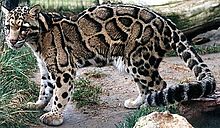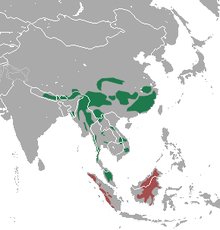Neofelis: Difference between revisions
Extended confirmed users, Pending changes reviewers 53,980 edits →Distribution of species: extended with ref re: N. diardi |
Extended confirmed users, Pending changes reviewers 53,980 edits →Controversy: rescued <ref name=christiansen> |
||
| Line 44: | Line 44: | ||
Apart from the location where the populations can be found, another noted discrepancy between the two species can be found in the number, size, and shape of the clouds for which the two species are named. Other differences include variation in the formation of the jaws and teeth. In a study conducted by Per Christiansen, the Sunda Islands Clouded Leopards tested showed to vary from the mainland species. They showed to have longer upper canines and a narrower palate between the upper canines. Apart from these Christiansen’s study also showed other differences in the skull apart from the mandibles.<ref name="christiansen"></ref> |
Apart from the location where the populations can be found, another noted discrepancy between the two species can be found in the number, size, and shape of the clouds for which the two species are named. Other differences include variation in the formation of the jaws and teeth. In a study conducted by Per Christiansen, the Sunda Islands Clouded Leopards tested showed to vary from the mainland species. They showed to have longer upper canines and a narrower palate between the upper canines. Apart from these Christiansen’s study also showed other differences in the skull apart from the mandibles.<ref name="christiansen"></ref> |
||
== Controversy == |
=== Controversy === |
||
Since its separation from Neofelis Nebulosa as a subspecies, Neofelis Diardi has had many opponents to its status as a full separate species. Many of these detractors have stated that Neofelis Diardi should not be awarded the rank of full species due to small variations in allopatric population, which is not uncommon.<ref name= |
Since its separation from Neofelis Nebulosa as a subspecies, Neofelis Diardi has had many opponents to its status as a full separate species. Many of these detractors have stated that Neofelis Diardi should not be awarded the rank of full species due to small variations in allopatric population, which is not uncommon.<ref name=christiansen>{{cite journal |last=Christiansen|first=P. |title=Species Distinction and Evolutionary Differences in the Clouded Leopard (Neofelis Nebulosa) and Diard's Clouded Leopard (Neofelis Diardi) |journal=Journal of Mammalogy |year=2008 |volume=89 |issue=6 |pages=1435-1446}}</ref> |
||
==References== |
==References== |
||
Revision as of 20:18, 8 December 2011
| Neofelis | |
|---|---|

| |
Clouded Leopard (Neofelis nebulosa)
| |
| Scientific classification | |
| Kingdom: | |
| Phylum: | |
| Class: | |
| Order: | |
| Family: | |
| Subfamily: | |
| Genus: | Neofelis Gray, 1867
|
| Species | |
| |

| |
| Neofelis range | |
Neofelis was first proposed by
Characteristics

Gray described the genus Neofelis as having an elongate
Distribution and habitat
Neofelis species range from
Distribution of species
Between 1821 and 1862, several clouded leopards have been described from Southeast Asia:
- Neofelis nebulosa was first described in 1821 by
- Neofelis diardi was first described in 1823 by Georges Cuvier under the name Felis Diardi based on a skin and a drawing received from Java.[11] The Sunda clouded leopard is probably restricted to the islands of Sumatra and Borneo.[6] In Java only clouded leopard fossils were found.[12]
Differences
The populations of Neofelis nebulosa are found in the Himalayan foothills, and range to Southeast Asia and the mainland of China.Neofelis diardi is found on the islands of Sumatra and Borneo.[6] [7] Apart from the location where the populations can be found, another noted discrepancy between the two species can be found in the number, size, and shape of the clouds for which the two species are named. Other differences include variation in the formation of the jaws and teeth. In a study conducted by Per Christiansen, the Sunda Islands Clouded Leopards tested showed to vary from the mainland species. They showed to have longer upper canines and a narrower palate between the upper canines. Apart from these Christiansen’s study also showed other differences in the skull apart from the mandibles.[13]
Controversy
Since its separation from Neofelis Nebulosa as a subspecies, Neofelis Diardi has had many opponents to its status as a full separate species. Many of these detractors have stated that Neofelis Diardi should not be awarded the rank of full species due to small variations in allopatric population, which is not uncommon.[13]
References
- ^ a b Gray, J.E. (1867). Notes on the skulls of the Cats. 5. Neofelis. Page 265–266 in: Proceedings of the Scientific Meetings of the Zoological Society of London for the year 1867.
- ^ Perseus Digital Library. Greek Dictionary νεο Headword Search Result
- ^ Perseus Digital Library. Latin Dictionary feles Headword Search Result
- ^ a b Pocock, R. I. (1917). The classification of existing Felidae. The Annals and Magazine of Natural History; zoology, botany, and geology, 8th ser. vol. 20 no. 119: 329–350.
- OCLC 62265494.
- ^ PMID 17141620.)
{{cite journal}}: CS1 maint: multiple names: authors list (link - ^ PMID 17141621.)
{{cite journal}}: CS1 maint: multiple names: authors list (link - ^ Pocock, R. I. (1939) The fauna of British India, including Ceylon and Burma. Mammalia. – Volume 1. Taylor and Francis, London.
- ^ a b Nowell, K., Jackson, P. (1996). Clouded Leopard in: Wild Cats: status survey and conservation action plan. IUCN/SSC Cat Specialist Group, Gland, Switzerland
- ^ Griffith, E. (1821). Felis nebulosa. Plate 37 in: General and particular descriptions of the vertebrated animals : arranged conformably to the modern discoveries and improvements in zoology. Volume 1: Order Carnivora. Baldwin, Cradock, and Joy, Rodwell and Martin, W. Wood, London.
- ^ Cuvier, G. (1823). Chapitre V. Des Ossemens de Grands Félis. Pages 407−456 in: Recherches sur les ossemens fossiles; ou, l'on retablit les caracteres de plusiers animaux dont les revolutions du globe ont detruit les especes. Volume IV: Les Ruminans et les Carnassiers Fossiles. Paris: G. Dufour & E. d'Ocagne
- ^ Meijaard, E. (2004). Biogeographic history of the Javan leopard Panthera pardus based on a craniometric analysis. Journal of Mammalogy 85: 302−310.
- ^ a b Christiansen, P. (2008). "Species Distinction and Evolutionary Differences in the Clouded Leopard (Neofelis Nebulosa) and Diard's Clouded Leopard (Neofelis Diardi)". Journal of Mammalogy. 89 (6): 1435–1446.
